A Brief History of Irish Stew
Irish stew is a dish steeped in history, dating back to the humble kitchens of rural Ireland. Originally crafted as a frugal way to use available ingredients, it became a symbol of sustenance for families during tough times. Traditional recipes highlight the simplicity of life on the Emerald Isle, where mutton, potatoes, onions, and water were the cornerstone ingredients. Over the centuries, this comforting meal has evolved, but its essence remains rooted in Irish culture—a hearty dish that nourishes both body and soul.
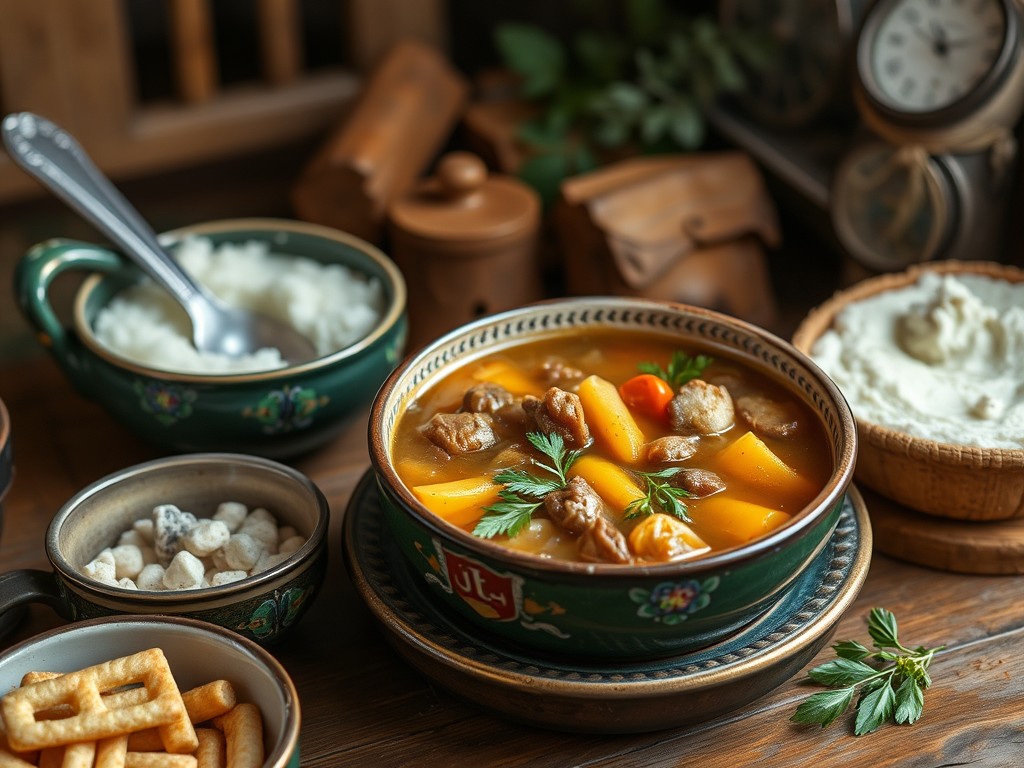
Table of Contents
Why Irish Stew is a Beloved Dish Around the World
What makes Irish stew a global favorite is its versatility and rich, hearty flavor. It’s a dish that transcends borders, perfect for warming up on a cold winter evening or as a celebratory meal during St. Patrick’s Day. The recipe for Irish stew is adaptable, allowing cooks to put their spin on the classic while maintaining its comforting, rustic charm. Whether served in a fine dining setting or a cozy family dinner, its ability to bring people together is unmatched.
Ingredients: The Heart of an Authentic Irish Stew
Traditional Ingredients: Lamb, Potatoes, Onions, and More
The cornerstone of any authentic Irish stew recipe lies in its simplicity. Traditionally, lamb or mutton forms the base, lending the dish its rich, gamey flavor. Potatoes, the quintessential Irish crop, add bulk and creaminess, while onions bring a sweet, aromatic depth. Many classic Irish stew recipes also include simple seasonings like salt and pepper, allowing the natural flavors of the ingredients to shine.
Choosing the Right Cut of Lamb for Maximum Flavor
When preparing a traditional recipe for Irish stew, selecting the right cut of lamb is critical. Bone-in cuts, such as shanks or neck, are ideal for their robust flavor and ability to tenderize during slow cooking. These cuts release gelatin into the broth, creating a rich, velvety texture that defines a perfect stew. For a leaner option, diced lamb shoulder is a popular choice, offering a balance of tenderness and flavor.
Variations in Vegetables: Carrots, Parsnips, and Beyond
While potatoes and onions are non-negotiable, many modern Irish stew recipes feature a colorful array of vegetables. Carrots add a natural sweetness that balances the savory notes of the lamb, while parsnips introduce a hint of nuttiness. Some cooks even experiment with turnips, leeks, or celery for added texture and flavor complexity. Each variation adds a personal touch to the dish, showcasing the adaptability of this timeless recipe.
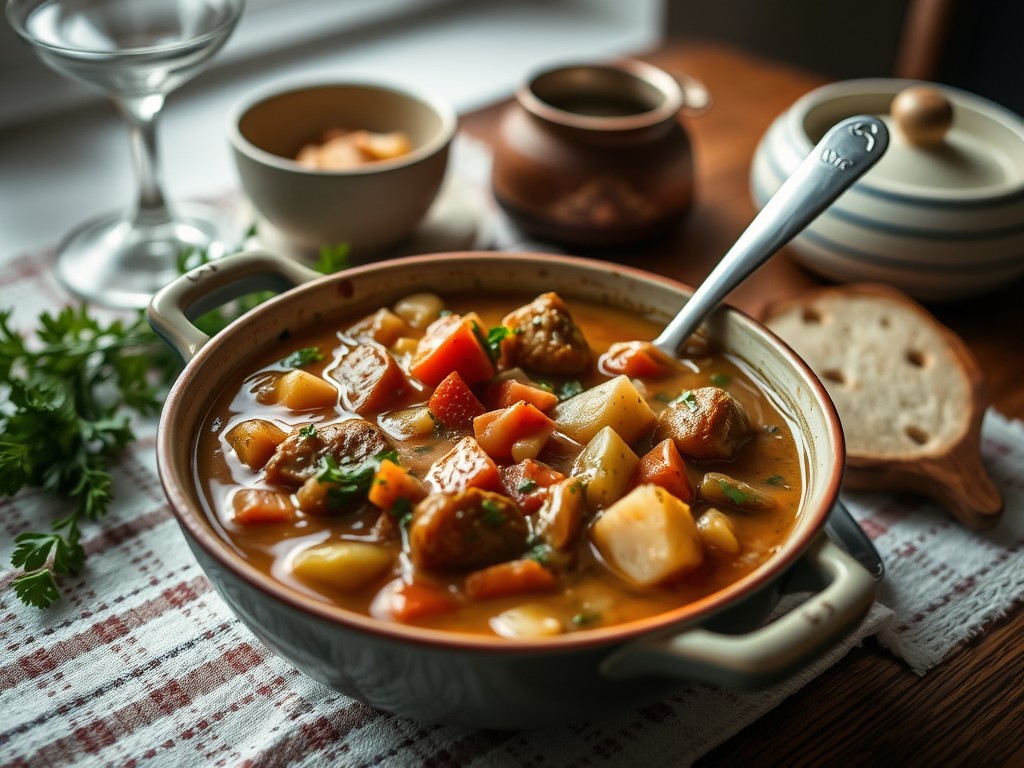
Herbs and Seasonings for an Authentic Taste
To elevate the flavor of your Irish stew, fresh herbs are essential. A sprig of thyme, a bay leaf, and a handful of parsley can transform the dish into a fragrant masterpiece. For a bolder flavor profile, some recipes include rosemary or even a touch of garlic. These elements infuse the broth with layers of taste, ensuring every spoonful is bursting with savory goodness. Don’t forget a final sprinkle of fresh parsley before serving—it not only enhances the aroma but also adds a vibrant splash of color.
Irish stew is more than just a dish; it’s a tradition that celebrates the simplicity of wholesome ingredients and the warmth of shared meals. By mastering the basics and exploring creative variations, you can make your own version of this timeless recipe. Whether you’re learning how to make Irish stew for the first time or perfecting your technique, the result will always be a bowl of hearty, heartwarming comfort.
Preparing Your Irish Stew: Step-by-Step Guide
Prepping the Ingredients: Tips for Cutting and Preparing
The foundation of a successful Irish Stew Recipe lies in meticulous preparation. Begin by selecting fresh, high-quality ingredients, as they are the heart of every dish. For the lamb, remove excess fat to avoid a greasy stew but leave some marbling for flavor. Chop the meat into evenly-sized chunks to ensure uniform cooking.
Vegetables should be peeled and cut into hearty, rustic pieces. Potatoes, a staple in most Irish stew recipes, can be cubed or sliced thickly depending on your preference. Carrots and parsnips should be chopped into large chunks to retain their texture during the long cooking process. Onions should be coarsely diced, allowing them to break down and add a natural sweetness to the broth. Proper preparation ensures that each ingredient contributes its unique flavor to the dish.
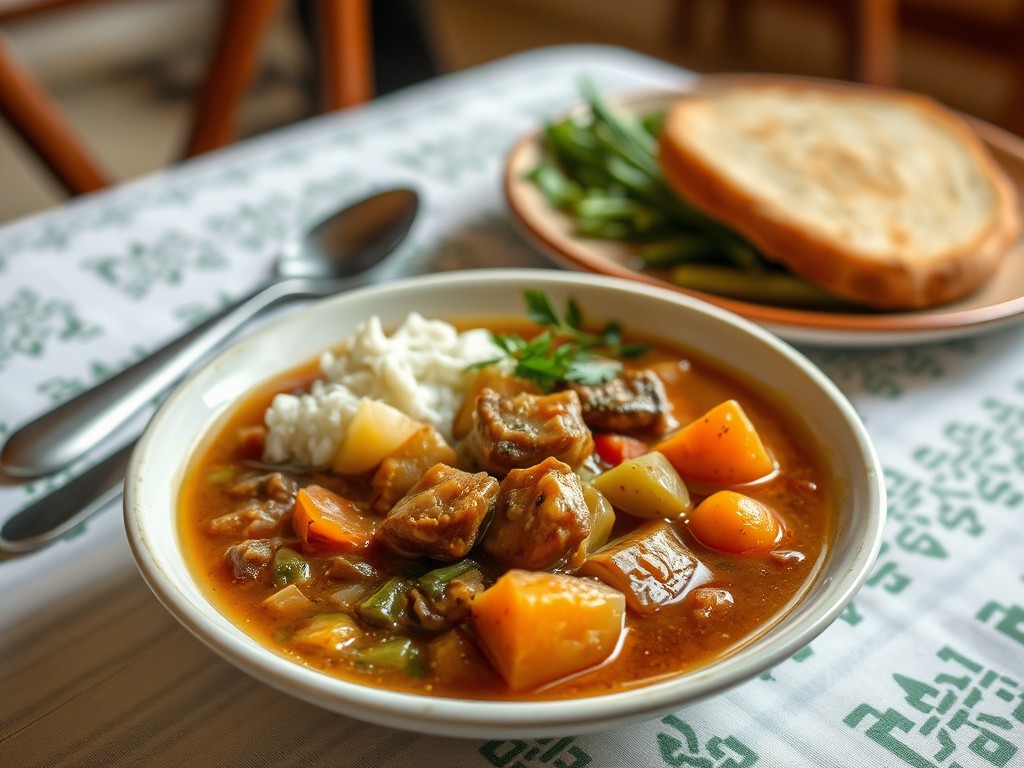
The Importance of Browning the Meat
Browning the meat is an essential step in creating a rich and flavorful Irish stew. Heat a heavy-bottomed pot or Dutch oven with a splash of oil, ensuring it is hot enough to sear the lamb. Place the meat in batches, avoiding overcrowding, and cook until it forms a deep, caramelized crust.
This process, known as the Maillard reaction, develops complex flavors that will elevate the dish. The browned bits left on the pot’s bottom, often called “fond,” are culinary gold. These bits dissolve during deglazing, enriching the broth with layers of depth. Skipping this step can result in a bland stew, so take the time to properly brown the meat.
Building the Base: Creating a Rich, Flavorful Broth
The broth is the soul of any recipe for Irish stew. Begin by deglazing the pot after browning the meat. A splash of water, stock, or even Guinness can loosen the fond and infuse the liquid with flavor.
Add the browned meat back into the pot along with a robust beef or lamb stock. For an authentic touch, include herbs such as thyme, bay leaves, and parsley stems. Simmer these ingredients gently to allow the flavors to meld together. Season gradually, tasting as you go to ensure a balanced profile. A well-developed broth transforms the stew into a dish that delights with every bite.
Layering Vegetables for Texture and Flavor
When layering vegetables, consider their cooking times. Root vegetables like carrots, potatoes, and parsnips should be added first, as they require more time to soften. Onions and leeks, which break down quickly, can be layered on top to infuse the broth with their sweetness.
For added depth, try sautéing the onions and garlic before adding them to the pot. This step enhances their natural sugars, creating a harmonious balance in the stew. The layering process ensures that each vegetable maintains its integrity, providing varied textures in every spoonful.
Slow Cooking vs. Instant Pot: Methods for Cooking Irish Stew
Traditionalists often swear by slow cooking when learning how to make Irish stew recipes. A low and slow approach allows the flavors to develop fully, resulting in tender meat and a rich, cohesive broth. Cooking on the stovetop or in a slow cooker for several hours is the classic method, ideal for those who enjoy the anticipation of a simmering pot.
For a quicker alternative, the Instant Pot delivers exceptional results. Pressure cooking significantly reduces the cooking time while retaining the dish’s depth of flavor. The Instant Pot method is perfect for busy cooks who still want an authentic-tasting stew. Both techniques produce satisfying results, so the choice depends on your schedule and preference.
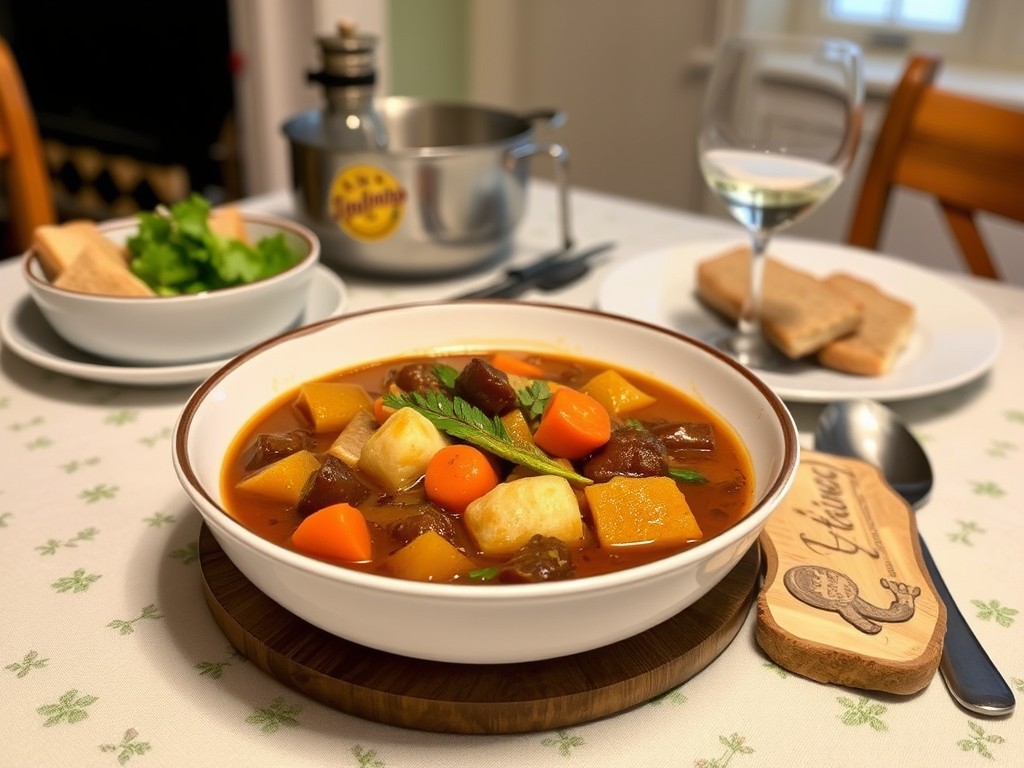
Variations on the Classic Recipe
Beef Stew: A Delicious Alternative
For those who prefer beef, this variation offers a hearty twist on the traditional Irish stew. Replace lamb with cuts like chuck roast or brisket, which are well-suited for slow cooking. The result is a robust dish with a slightly different flavor profile, perfect for those who enjoy a richer meat base.
Follow the same principles of browning, layering, and slow cooking to ensure a flavorful outcome. Adding a splash of red wine to the broth complements the beef beautifully, creating a dish that rivals the classic lamb version in popularity.
Vegetarian and Vegan Irish Stew Options
Irish stew recipes can be easily adapted for vegetarians and vegans without sacrificing heartiness. Replace the meat with hearty alternatives like mushrooms, lentils, or chickpeas. These ingredients mimic the texture of meat and absorb the stew’s flavors beautifully.
Vegetable broth replaces the traditional meat-based stock, and additional herbs like rosemary or oregano can enhance the flavor. Root vegetables remain the star, with turnips, sweet potatoes, and parsnips providing a satisfying depth. This plant-based variation ensures everyone can enjoy the comforting tradition of Irish stew.
Adding a Modern Twist: Wine, Guinness, or Cream
For a contemporary take on the classic recipe, consider incorporating ingredients like wine, Guinness, or cream. A splash of red or white wine adds sophistication and enhances the broth’s flavor. Guinness, a beloved Irish stout, imparts a deep, malty richness that pairs exceptionally well with lamb or beef.
For a creamier variation, stir in a splash of heavy cream or crème fraîche near the end of cooking. This luxurious addition creates a velvety texture and balances the stew’s savory elements with subtle sweetness. These modern touches allow cooks to personalize the dish while honoring its roots.
Irish stew is a dish that invites creativity while staying true to its origins. Whether sticking to tradition or experimenting with modern variations, this iconic recipe offers endless possibilities for culinary enjoyment. By mastering the techniques and exploring innovative twists, you can craft a stew that warms hearts and fills bellies on any occasion.
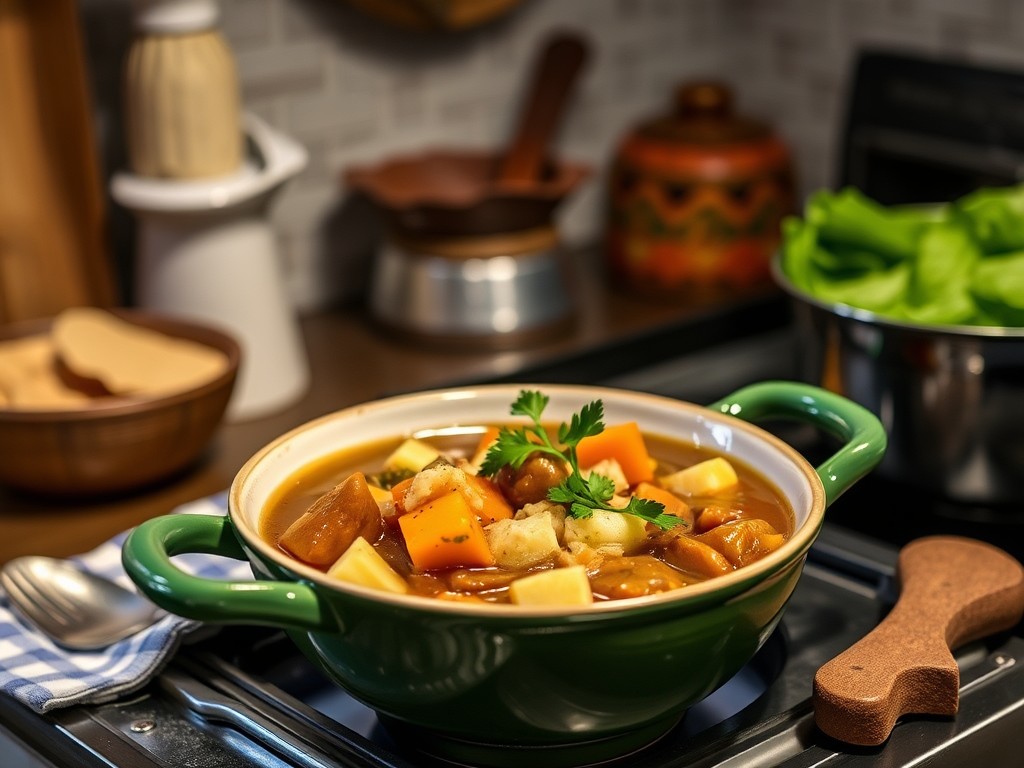
Serving Irish Stew: Tips and Pairings
The Perfect Sides: Soda Bread, Colcannon, and More
It isn’t as if an Irish Stew Recipe can be incomplete without the ideal side dishes to go with it. Soda bread, which is a classic Irish popular is a fantastic option. Its very dense texture and delicate tanginess makes it perfect to soak up the delicious broth from the stew. Serve it hot, right out of the oven for the perfect touch.
Colcannon is a warm mix made of cabbage, potatoes and butter, goes beautifully with the rich and savory flavor that are typical of Irish stew. The creamy texture contrasts wonderfully with the stew’s hefty veggies as well as the tender meat.
Some other options for side dishes are buttery peas and roasted parsnips, and an even fresh and crisp salad that will lighten up the dish. Every side dish adds to the dining experience in general and transforms a basic recipe to make Irish stew into an extraordinary meal.
Drinks That Complement Irish Stew: From Ales to Wines
Drinking with Irish stew can add an additional level of pleasure. Traditionalists typically choose a pint of Irish beer or even a stout like Guinness. The malty sweetness of the ale is a perfect match for the earthy flavor of the stew, resulting in the perfect combination.
Wine lovers will appreciate red wines such as Cabernet Sauvignon or Merlot work perfectly. Their vibrant, fruity flavors will cut through the richness the lamb, and help balance the flavor of the stew. If you’re looking for more lightness, a refreshing Sauvignon Blanc or Pinot Grigio provides a refreshing counterpoint to the meaty flavor of the stew.
Drinks that are not alcoholic, such as sparkling water that has the slice of lemon, or spiced apple cider could also help enhance your meal. It is important to select drinks that compliment and not overpowers the rich flavor of the stew.
Presentation Ideas for Festive Occasions
Enhance the quality of your Irish stew recipes to celebrate special occasions with an elegant design and presentation. Utilize earthenware, rustic bowls to showcase the stew’s classic origins. Add a few sprigs of fresh thyme or parsley for some color and an inviting scent.
If you want to set a memorable table Serve the stew in small pieces of soda bread, wrapped in napkins of linen. Serve small bowls of butter or flavor spreads to provide guests with a unique flavor.
If your meal is served at or at a buffet, place the stew in an enormous cast iron pot with a variety of dishes to create a communal and family-style meal. If you’re having a formal or casual dinner your presentation of the recipe to make Irish stew will make your dish feel unique.
Tips for Perfecting Your Irish Stew
Avoiding Common Mistakes: Overcooking, Bland Flavors, and More
The best Irish stew recipes could be a disaster if you don’t pay attention to the smallest of details. The most common error is cooking too long for the veggies. To avoid this, you should add roots vegetables such as carrots and potatoes at the beginning, while preserving the more delicate ingredients, like peas or leeks, to be added later cooking.
A second crucial aspect is the seasoning. Don’t add too much salt right at the beginning, as flavors develop while the stew heats up, and excessive salting can harm the flavor of the stew. Be sure to season slowly and check the taste often.
To prevent blandness, you should make sure to cook the meat thoroughly prior to making it into the stew. This adds a an extra dimension to the stew ensuring that it’s delicious and full of flavor. Also, make sure you use plenty of the spices and herbs. Fresh bay leaves, fresh thyme as well as parsley can make the stew more appealing making a straightforward method of making an Irish stew into a gourmet masterpiece.
Storing and Reheating Leftovers: Maintaining Flavor and Texture
Irish stew usually tastes more delicious the following day because the flavors will have time to mix. For storage, place the stew that has cooled into an airtight container. Refrigerate for up to 3 days. If you want to reheat the stew, cook it on an oven with a lower heat setting or a microwave with a moderate setting to preserve the consistency of the stew.
If the broth is been thickened to much within the refrigerator You can add some water or stock when reheating for a smoother consistency. Mix frequently so that heat is distributed evenly, and to prevent the bottom from becoming scorched. Following these guidelines the stew you have left is as delicious as your first meal.
Making Ahead for Busy Days: Freezing and Meal Prep Tips
For busy people, Irish stew is a great meal that can be made ahead. Create a double-sized batch and store portions in separate containers to make it easy for weeknight meals.
Before freezing, be sure your stew is cool in order to prevent the formation of ice crystals that can affect the quality. Make use of freezer-safe containers, or large-duty bags. Leave a bit of extra room to expand. Mark the container with the date and the contents for quick identification.
To heat it up, let your stew inside the fridge over night and then warm it up over the stove or by heating it in the microwave. It doesn’t only help protect the stew, but it allows the flavors to intensify, so that every bite is just as good like freshly prepared.
Making a perfect recipe to make Irish stew requires much more than simply cooking. It’s all about creating a memorable enjoyment. From selecting the appropriate sides and beverages to figuring out ways to store and present the dish each element contributes to an experience that’s delicious and unforgettable. If you’re hosting the family dinner or having an intimate dinner in your home, Irish stew is a traditional dish that can bring warmth and pleasure to all occasions.
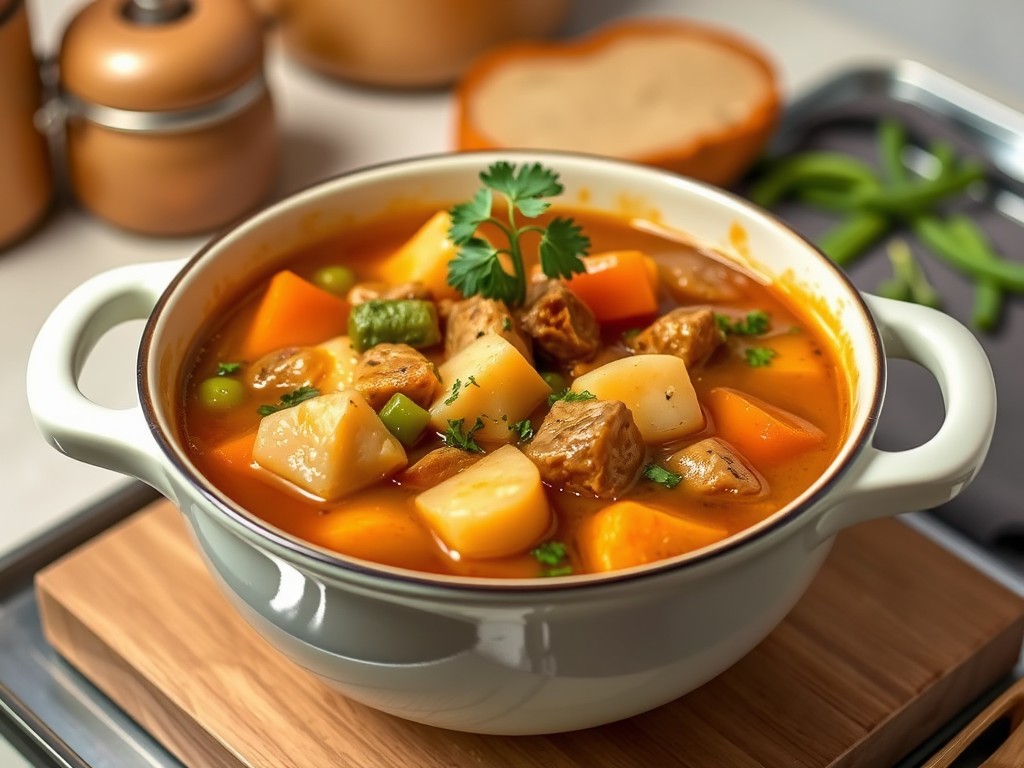
Cultural Significance of Irish Stew
Irish Stew in Literature and Film
Through time, the simple Irish Stew Recipe is more than just an ordinary dish, it has also become an emblem of the culture. The stew is frequently featured in literature and films as a representation of Irish character, strength as well as hospitality. In the novel of James Joyce’s Dubliners the meals such as Irish stew convey a feeling of tradition and community. Similar to the way that films that are set in Ireland typically feature the steaming pots of this nourishing stew as a comforting meal that anchors characters to their roots.
The depictions reflect the role of stew in the telling of stories. It connects the food and memory with culture. The stew recipe Irish stew goes beyond mere food and drink and is a link to the rich history of Ireland.
Celebration of St. Patrick’s Day by drinking Irish Stew
If St. Patrick’s Day rolls around, Irish stew becomes a regular at tables around the world. The simplicity of the dish and its robust flavor makes it the perfect food to serve at parties. Classic ingredients such as lamb, potatoes and onions allude to the Irish agricultural heritage, as variations accommodate contemporary tastes.
With soda bread and the option of a pint Guinness, Irish stew recipes are a perfect example of celebration. If served during pub parties or at family gatherings it’s more than just a meal. It’s an opportunity to celebrate Irish traditions and camaraderie.
A Dish That Brings Families Together
Irish stew has been an unifying factor for families. Traditions passed down through generations and generations, the recipe for Irish stew recipe usually has sentimental significance. The grandparents teach their children the art of layering their ingredients and each stage is filled with tales and laughter.
Sharing a meal together builds bonds that transform a common stew into a beloved routine for families. Making food and sharing meals together creates a sense of connection and makes Irish stew a meal which is nourishing for body and soul.
Conclusion
Why Irish Stew Remains a Timeless Classic
The long-lasting appeal of Irish stew is in its simpleness and versatility. The basic ingredients – potatoes, lamb and root vegetables are readily available and inexpensive, but stew is a source of endless possibilities to experiment with your ideas. Its origins range from an aristocratic meal, to its use in modern festivities The dish recipe of Irish stew remains evolving, and remain authentic to its original roots.
Beyond the taste, Irish stew represents a connection to the past and culture, as well as a way to celebrate the past as well as a testimony to the value of family traditions. Because of its longevity, it is sure to be a favorite food for the generations to follow.
Encouragement to Experiment and Make It Your Own
One of the great things about Irish stew is the variety it can be made with. While the traditional Irish stews provide a wonderful base, it’s not a bad idea to customize the stew recipe and make it your individual. Add seasonal veggies and spices or perhaps adding the addition of alcohol or stout to give it an updated variation.
Cooking is an art form, and Irish stew is a great opportunity to express your creativity. If you modify the method of making Irish stew recipes to fit your personal tastes it honors its history by adding your own personal twist that expresses your individual taste.
FAQs
Which is the source of Irish stew?
Irish stew began as an easy, nutritious dish made by Irish farmers. The stew was prepared using inexpensive, easily available ingredients such as lamb onions, potatoes and potatoes to make a delicious meal that would feed huge households.
What can I do to cook Irish stew vegan?
Yes! Vegetarian variations that are based on this Irish Stew Recipe are very popular and tasty. Replace the meat with nourishing alternatives like lentils or mushrooms and then use vegetable broth as the broth base.
What is the most efficient way to preserve leftovers?
The stew leftovers can be stored in an airtight container and keep it in the refrigerator for up three days. Warm gently on the stove or in the microwave to preserve its texture and flavor.
Do I have the ability to put it in a freezer? Irish stew?
Absolutely! Irish stew freezes very well. The stew should be completely cooled before you transfer it into freezer-safe containers. It is able to be stored for up to 3 months. It is reheated beautifully to make an easy, warm meal.
Which sides go best to Irish stew?
Colcannon, soda bread, or a simple salad can complement this dish of Irish stew perfect. The addition of these ingredients enhances the flavor of the stew while providing some variety to the food.
How can I stay clear of the taste of a boring Irish stew?
In order to ensure that the stew you cook tastes delicious, cook the meat in a thorough manner and add seasoning slowly throughout cooking. The addition of fresh herbs, such as bay leaves or thyme gives depth to the stew recipe. Irish stew.
Do I have to use the beef in place or lamb?
Beef is indeed an extremely popular variation. Although lamb is known for its traditional taste, beef is an incredibly satisfying, rich option which is great in all Irish stew recipes..
Irish stew is much more than it’s just a meal. It’s an expression of family history, heritage as well as culinary innovation. If you’re sticking with the traditional or exploring new recipes this classic dish will bring warmth, nutrition and unforgettable memories with each cup.




